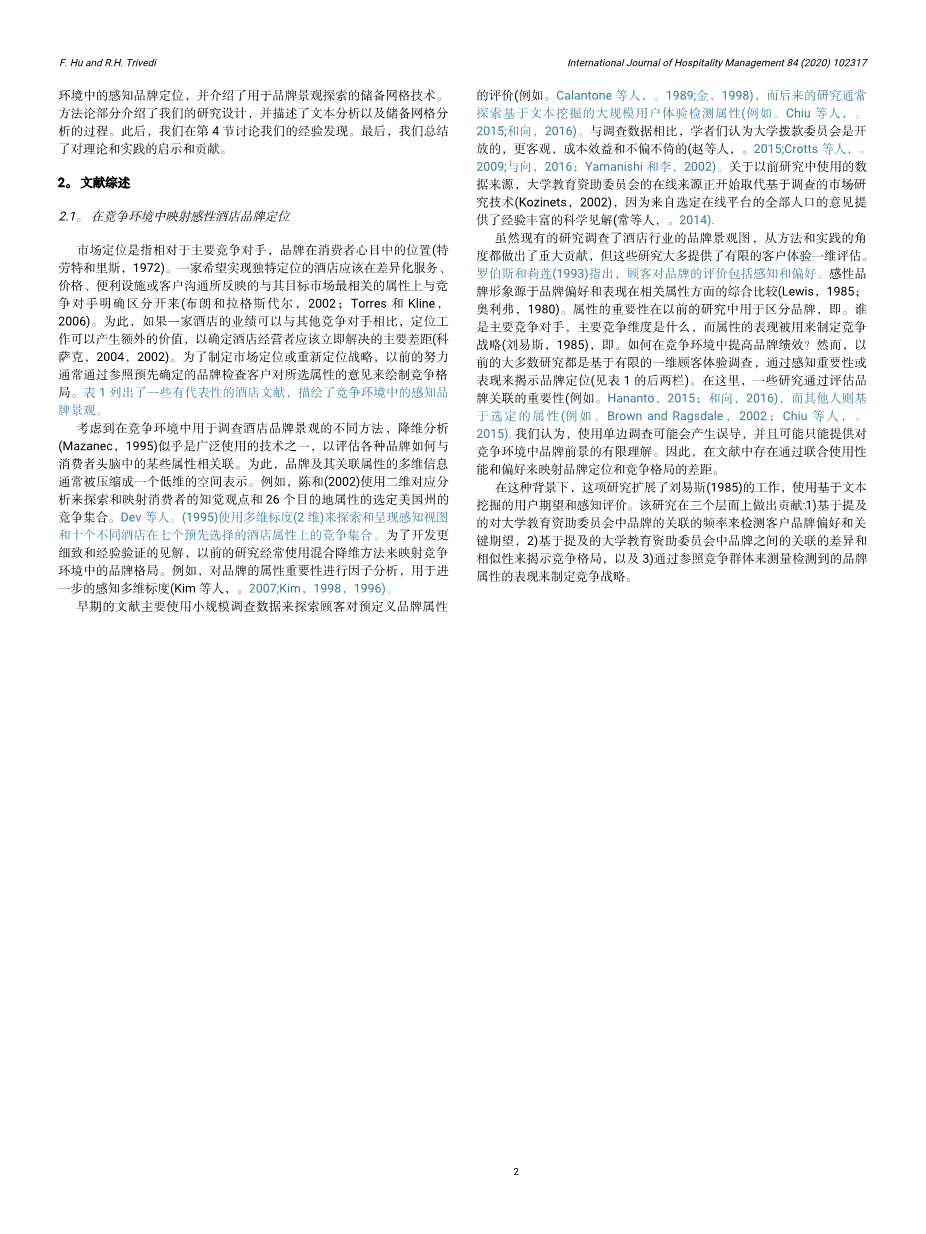InternationalJournalofHospitalityManagement84(2020)102317
Contents lists available at ScienceDirect
International Journal of Hospitality Management
journal homepage: www.elsevier.com/locate/ijhm
Mapping hotel brand positioning and competitive landscapes by text-mining user-generated content
Feng Hua,b, Rohit H. Trivedic,⁎
a Xingzhi College, Zhejiang Normal University, Jinhua, 31004, China
b University of Hamburg, Von-Melle-Park 5, 20146, Hamburg, Germany
c University of Bradford, Emm Lane, Bradford, BD9 4JL, UK
A R T I C L E I N F O
Keywords:
Brand positioning Competitive landscape Repertory grid analysis Text mining
User-generated content
A B S T R A C T
This study uncovers hotel brand positioning and competitive landscape mapping by text-mining user-generated content (UGC). Rather than relying on a single dimension of consumer evaluation, the current study detects brand attributes by using both customer preferences as well as perceptual performance to develop meaningful insights. For this, the study combines content analysis and repertory grid analysis (RGA) to answer three key research issues. 111,986 hotel reviews from two biggest Chinese cities are used to explore and visualize the competitive landscape of six selected hotel brands across three hotel categories. Findings from the study will not only advance the existing literature on brand positioning and competitive landscape mapping but also help practitioners in developing brand positioning strategies to fight competitors within and across hotel categories.
Introduction
In the hospitality industry, building a strong hotel brand positioning requires more than just associating a property with a name and a logo or creating a marketing campaign (Cai and Hobson, 2004). In order to create a unique and differentiated hotel brand positioning, marketer need to develop a strategy that not only relates to the needs of the consumers (Choi and Chu, 2001; Oh and Parks, 1997) but also differ- entiate the property and value proposition meaningfully from other competing hotels in the same market (Park et al., 1986). A hotel can create unique positioning based on a set of differentiated attributes, targeting a specific user group/s or for a specific usage category (Brown and Ragsdale, 2002; Lewis, 1985). In any case, a unique brand posi- tioning will result into not only higher occupancy, repeat visit and service patronage, but also increased profitability and relative re- siliency during down industry cycle. Thus, it is perennially important for a marketer to understand how to uniquely position a specific hotel
brand by deploying a judicious mix of most appropriate resources and
communicating message that resonate to a specific consumer segment (Brown and Ragsdale, 2002; Dev et al., 1995; Park et al., 1986). An additional critical issue facing hotel looking for a strong brand posi- tioning is to distant itself from other competitors by offering and communicating unique tangible and intangible benefits that are diffi- cult for a competitors to copy (Anderson et al., 1999).
To this effect, it is necessary to examine the hotel brand positioning
from consumersrsquo; perspective and examine the performance of various competing hotels in a market so as to achieve a clear positioning with strong market orientation (Plumeyer et al., 2017). Previous literature in hospitality industry commonly explored hotel brand positioning and competitive landscape issues by either using survey data (e.g., Brown and Ragsdale, 2002; Dev et al., 1995) limiting the insights to pre-spe- cified questions or mining UGC with reliance on a single dimension of consumer evaluations (e.g., Chiu et al., 2015; Krawczyk and Xiang, 2016). The conventional survey-based techniques are characterized by an inherently high dependence on relatively small samples with in- formation selectivity bias and thus believed relatively weak in re- flecting holistic customer experience (Krawczyk and Xiang, 2016; Lau et al., 2005). On other hand, recent studies employing large size UGC largely limited the inquiry to a unidimensional evaluation of consumer opinion on detected brand attributes on importance (e.g., Krawczyk and
Xiang, 2016) or perceptual performance (Chiu et al., 2015) offering
implications that are lopsided with limited practical usability in brand positioning/repositioning decisions (Keller, 1993; Lewis, 1985). Ac- cording to the Expectancy Confirmation Theory (ECT) introduced by Oliver (1980), customer evaluation is the result of comprehensive comparison between customer expectation and perception and both of them should be used to under
剩余内容已隐藏,支付完成后下载完整资料


英语译文共 12 页,剩余内容已隐藏,支付完成后下载完整资料
资料编号:[605509],资料为PDF文档或Word文档,PDF文档可免费转换为Word
课题毕业论文、开题报告、任务书、外文翻译、程序设计、图纸设计等资料可联系客服协助查找。
您可能感兴趣的文章
- 饮用水微生物群:一个全面的时空研究,以监测巴黎供水系统的水质外文翻译资料
- 步进电机控制和摩擦模型对复杂机械系统精确定位的影响外文翻译资料
- 具有温湿度控制的开式阴极PEM燃料电池性能的提升外文翻译资料
- 警报定时系统对驾驶员行为的影响:调查驾驶员信任的差异以及根据警报定时对警报的响应外文翻译资料
- 门禁系统的零知识认证解决方案外文翻译资料
- 车辆废气及室外环境中悬浮微粒中有机磷的含量—-个案研究外文翻译资料
- ZigBee协议对城市风力涡轮机的无线监控: 支持应用软件和传感器模块外文翻译资料
- ZigBee系统在医疗保健中提供位置信息和传感器数据传输的方案外文翻译资料
- 基于PLC的模糊控制器在污水处理系统中的应用外文翻译资料
- 光伏并联最大功率点跟踪系统独立应用程序外文翻译资料



